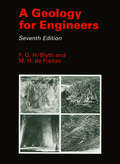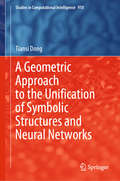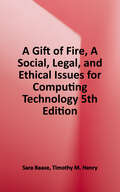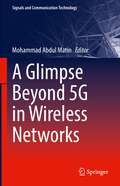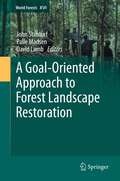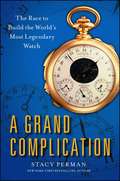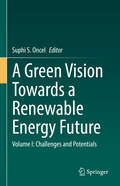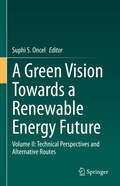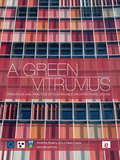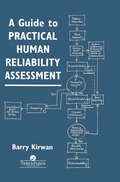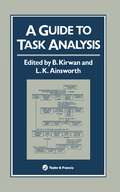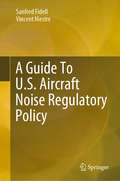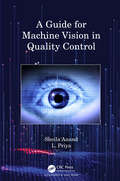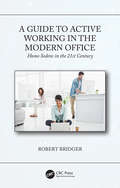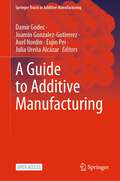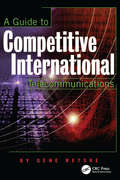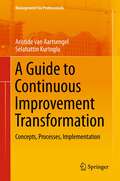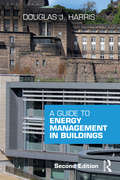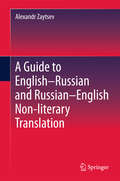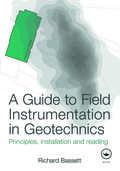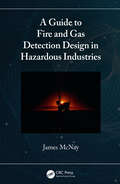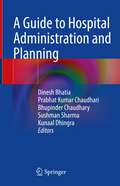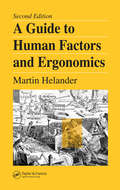- Table View
- List View
A Geology for Engineers
by F.G.H. Blyth Michael De FreitasNo engineering structure can be built on the ground or within it without the influence of geology being experienced by the engineer. Yet geology is an ancillary subject to students of engineering and it is therefore essential that their training is supported by a concise, reliable and usable text on geology and its relationship to engineering. In this book all the fundamental aspects of geology are described and explained, but within the limits thought suitable for engineers. It describes the structure of the earth and the operation of its internal processes, together with the geological processes that shape the earth and produce its rocks and soils. It also details the commonly occurring types of rock and soil, and many types of geological structure and geological maps. Care has been taken to focus on the relationship between geology and geomechanics, so emphasis has been placed on the geological processes that bear directly upon the composition, structure and mechanics of soil and rocks, and on the movement of groundwater. The descriptions of geological processes and their products are used as the basis for explaining why it is important to investigate the ground, and to show how the investigations may be conducted at ground level and underground. Specific instruction is provided on the relationship between geology and many common activities undertaken when engineering in rock and soil.
A Geometric Approach to the Unification of Symbolic Structures and Neural Networks (Studies in Computational Intelligence #910)
by Tiansi DongThe unification of symbolist and connectionist models is a major trend in AI. The key is to keep the symbolic semantics unchanged. Unfortunately, present embedding approaches cannot. The approach in this book makes the unification possible. It is indeed a new and promising approach in AI. -Bo Zhang, Director of AI Institute, TsinghuaIt is indeed wonderful to see the reviving of the important theme Nural Symbolic Model. Given the popularity and prevalence of deep learning, symbolic processing is often neglected or downplayed. This book confronts this old issue head on, with a historical look, incorporating recent advances and new perspectives, thus leading to promising new methods and approaches. -Ron Sun (RPI), on Governing Board of Cognitive Science SocietyBoth for language and humor, approaches like those described in this book are the way to snickerdoodle wombats. -Christian F. Hempelmann (Texas A&M-Commerce) on Executive Board of International Society for Humor Studies
A Gift of Fire: Social, Legal, and Ethical Issues for Computing Technology
by Sara Baase Timothy M. HenryFor courses in Computer Ethics and Computers and Society. An objective study of technology ethics that inspires critical thinking and debate, <p><p> In Gift of Fire, A: Social, Legal, and Ethical Issues for Computing Technology, Sara Baase presents a balanced exploration of the social, legal, philosophical, ethical, political, constitutional, and economic implications of computing and the controversies they raise. With an objective computer scientist's perspective, and with historical context for many issues, Baase covers the issues readers will face both as members of a technological society and as professionals in computer-related fields. A primary goal is to develop computer professionals who understand the implications of what they create and how it fits into society at large. This text encourages readers to think about the ethics and philosophical direction behind topics but doesn't lead students to conclusions. <p><p>The 5th Edition contains updated material on new topics and examples, outdated material has been removed, and several topics have been reorganized. New material appears throughout, including material on current trending topics such as drones and autonomous cars.
A Glimpse Beyond 5G in Wireless Networks (Signals and Communication Technology)
by Mohammad Abdul MatinThis book gathers the latest research findings on emerging trends in 5G and beyond wireless systems. The authors present and assess different enabling technologies, capabilities, and anticipated communications and computing solutions for 5G and beyond. Topics discussed include new frequency bands, new multiple antenna systems, massive D2D connectivity, new network deployment, and more. These discussions help the readers to understand more advanced research materials for developing new ideas to make a contribution in this field for themselves. This book aims to serve as a virtual and effective bridge between academic research in theory and engineering development in practice. Students, professional, and practitioners who seek to learn the latest development in wireless technologies should find interest in this book.
A Global History of Warfare and Technology: From Slings to Robots
by Kaushik RoyThis book addresses the global history of technology, warfare and state formation from the Stone Age to the Information Age. Using a combination of top-down and bottom-up methodologies, it examines both interstate and intrastate conflicts with a focus on Eurasian technology and warfare. It shows how human agency and structural factors have intertwined, creating a complex web of technology and warfare. It also explores the interplay between technological and non-technological factors to chart the evolution of warfare from its origins to the present day, arguing that the interactions between civilian and military sectors have shaped the use of technology in warfare. Given its scope and depth, it is a valuable resource for researchers in fields such as world history, history of science and technology, history of warfare and imperialism and international relations.
A Goal-Oriented Approach to Forest Landscape Restoration (World Forests #16)
by David Lamb John Stanturf Palle MadsenWhile restoration ecology has traditionally aimed to re-create some putative more 'natural' ecological state, forest landscape restoration (FLR) has emerged over the last decade as an approach aimed more at restoring natural functions, while focusing on meeting human needs. With a view to exploring the practical potential of this approach, this book draws together a team of experts from the natural and social sciences to discuss its success so far in addressing critical issues such as biodiversity, ecological function, and human livelihoods. Applying principles of landscape ecology, restoration ecology, planning theory and conflict management, the book presents a series of case studies which document the approach, and discusses how the approach can help with priority setting for the future. The book will provide a valuable reference to graduate students and researchers interested in ecological restoration, forest ecology and management, as well as to professionals in environmental restoration, natural resource management, conservation, and environmental policy.
A Grand Complication: The Race to Build the World's Most Legendary Watch
by Stacy PermanTwo wealthy and powerful men engage in a decades-long contest to create and possess the most remarkable watch in history.James Ward Packard of Warren, Ohio, was an entrepreneur and a talented engineer of infinite curiosity, a self-made man who earned millions from his inventions, including the design and manufacture of America&’s first luxury car—the elegant and storied Packard. Henry Graves, Jr., was the very essence of blue-blooded refinement in the early 1900s: son of a Wall Street financier, a central figure in New York high society, and a connoisseur of beautiful things—especially fine watches. Then, as now, expensive watches were the ultimate sign of luxury and wealth, but in the early twentieth century the limitless ambition, wealth, and creativity of these two men pushed the boundaries of mathematics, astronomy, craftsmanship, technology, and physics to create ever more ingenious timepieces. In any watch, features beyond the display of hours, minutes, and seconds are known as &“complications.&” Packard and Graves spurred acclaimed Swiss watchmaker Patek Philippe to create the Mona Lisa of timepieces—a fabled watch that incorporated twenty-four complications and took nearly eight years to design and build. For the period, it was the most complicated watch ever created. For years it disappeared, but then it surfaced at a Sotheby&’s auction in 1999, touching off a heated bidding war, shattering all known records when it fetched $11 million from an anonymous bidder. New York Times bestselling author Stacy Perman takes us from the clubby world of New York high society into the ateliers of the greatest Swiss watchmakers, and into the high-octane, often secretive subculture of modern-day watch collecting. With meticulous research, vivid historical details, and a wealth of dynamic personalities, A Grand Complication is the fascinating story of the thrilling duel between two of the most intriguing men of the early twentieth century. Above all, it is a sweeping chronicle of innovation, the desire for beauty, and the lengths people will go to possess it.
A Green Vision Towards a Renewable Energy Future: Volume I: Challenges and Potentials
by Suphi S. OncelThis 2-volume set provides an overview of the global progress in achieving renewable energy goals through sustainable and economically viable means. Volume I presents the background on renewable energy achievements thus far, and the technological, economic and policy challenges to realizing renewable energy goals. This then leads into a discussion of how a transition to a green economy based on renewable energy could be achieved, including global opportunities, trends, policy considerations and societal implications. The book will appeal to academics, industry professionals and policy makers engaged with the energy economy, renewable energy research and environmental sustainability.
A Green Vision Towards a Renewable Energy Future: Volume II: Technical Perspectives and Alternative Routes
by Suphi S. OncelThis 2-volume set provides an overview of the global progress in achieving renewable energy goals through sustainable and economically viable means. Volume II covers various potential renewable energy sources such as solar, wind, hydro and biomass, including the technologies associated with each that are economically feasible while still being environmentally sustainable in their implementation. This then leads into a discussion of how a transition to a green economy based on renewable energy could be achieved, including global opportunities, trends, policy considerations and societal implications. The book will appeal to academics, industry professionals and policy makers engaged with the energy economy, renewable energy research and environmental sustainability.
A Green Vitruvius: Principles and Practice of Sustainable Architectural Design
by Vivienne Brophy J Owen Lewis2000 years ago the roman architect Marcus Vitruvius Pollio wrote the ten books on architecture establishing the concept of the pattern book offering design principles and solutions that is still referred to in every architect's education. A Green Vitruvius is intended as a green pattern book for today. Now fully updated, this well established textbook provides advice suitable for undergraduate and post graduate students on the integration of sustainable practice into the design and construction process, the issues to be considered, the strategies to be adopted, the elements of green design and design evaluation within the process. Classic design elegance is found in the holistic clear solution.
A Guide To Practical Human Reliability Assessment
by B. KirwanHuman error is here to stay. This perhaps obvious statement has a profound implication for society when faced with the types of hazardous system accidents that have occurred over the past three decades. Such accidents have been strongly influenced by human error, yet many system designs in existence or being planned and built do not take human error into consideration.; "A Guide to Practical Human Reliability Assessment" is a practical and pragmatic guide to the techniques and approaches of human reliability assessment HRA. lt offers the reader explanatory and practical methods which have been applied and have worked in high technology and high risk assessments - particularly but not exclusively to potentially hazardous industries such as exist in process control, nuclear power, chemical and petrochemical industries.A Guide to Practical Human Reliability Assessment offers the practitioner a comprehensive tool-kit of different approaches along with guidance on selecting different methods for different applications. It covers the risk assessment and the HRA process, as well as methods of task analysis, error identification, quantification, representation of errors in the risk analysis, followed by error reduction analysis, quality assurance and documentation. There are also a number of detailed case studies from nuclear, chemical, offshore, and marine HRA'S, exemplfying the image of techniques and the impact of HRA in existing and design-stage systems.
A Guide To Task Analysis: The Task Analysis Working Group
by B. Kirwan L. K. AinsworthThis work shows readers how to target task analysis TA resources effectively over the life cycle of a project from conceptual design Through To Systems Operation, Noting The Role Of TA In Safety And Quality assurance, minimizing operator error,
A Guide To U.S. Aircraft Noise Regulatory Policy (Springerbriefs In Applied Sciences And Technology Ser.)
by Sanford Fidell Vincent MestreAviation noise remains the primary hindrance to expansion of airport and airspace capacity in the United States. This book describes the development and practice of U.S. aircraft noise regulation, as well as the practical consequences of regulatory policy. Starting in the pre-jet transport era, the book traces the development of the modern framework for characterizing, standardizing, predicting, disclosing, and mitigating aircraft noise and its effects on airport-vicinity communities. Among other matters, the book treats noise-related consequences of the 1978 deregulation of the airline industry; prediction and mitigation of community reaction to airport noise; land use compatibility planning; recent research and industry trends; and some suggestions for potential improvements to current policy. Initial chapters describe the assumptions underlying aircraft noise regulation, and lay out the chronology of U.S. aircraft noise regulatory practice. Later chapters provide overviews of population-level effects of aviation noise, including health effects, speech and sleep interference, and annoyance. Readers will learn why predictions of the prevalence of aircraft noise-induced annoyance have systematically underestimated adverse community response to aircraft noise, and how such underestimation has complicated approval and funding of airport and airspace improvement projects. They will also learn why attempts at noise-compatible land use planning are seldom fully successful.
A Guide for Machine Vision in Quality Control
by Sheila Anand L. PriyaMachine Vision systems combine image processing with industrial automation. One of the primary areas of application of Machine Vision in the Industry is in the area of Quality Control. Machine vision provides fast, economic and reliable inspection that improves quality as well as business productivity. Building machine vision applications is a challenging task as each application is unique, with its own requirements and desired outcome. A Guide to Machine Vision in Quality Control follows a practitioner’s approach to learning machine vision. The book provides guidance on how to build machine vision systems for quality inspections. Practical applications from the Industry have been discussed to provide a good understanding of usage of machine vision for quality control. Real-world case studies have been used to explain the process of building machine vision solutions. The book offers comprehensive coverage of the essential topics, that includes: Introduction to Machine Vision Fundamentals of Digital Images Discussion of various machine vision system components Digital image processing related to quality control Overview of automation The book can be used by students and academics, as well as by industry professionals, to understand the fundamentals of machine vision. Updates to the on-going technological innovations have been provided with a discussion on emerging trends in machine vision and smart factories of the future. Sheila Anand is a PhD graduate and Professor at Rajalakshmi Engineering College, Chennai, India. She has over three decades of experience in teaching, consultancy and research. She has worked in the software industry and has extensive experience in development of software applications and in systems audit of financial, manufacturing and trading organizations. She guides Ph.D. aspirants and many of her research scholars have since been awarded their doctoral degree. She has published many papers in national and international journals and is a reviewer for several journals of repute. L Priya is a PhD graduate working as Associate Professor and Head, Department of Information Technology at Rajalakshmi Engineering College, Chennai, India. She has nearly two decades of teaching experience and good exposure to consultancy and research. She has delivered many invited talks, presented papers and won several paper awards in International Conferences. She has published several papers in International journals and is a reviewer for SCI indexed journals. Her areas of interest include Machine Vision, Wireless Communication and Machine Learning.
A Guide to Active Working in the Modern Office: Homo Sedens in the 21st Century
by Robert BridgerThis is a short guide on sit-stand working in the office. It reviews the research on sitting and standing at work from the 1950s to present and provides guidance for specialists, therapists, practitioners, and managers. The book is illustrated with many photos and figures, provides guidance for active working at the end of every chapter, and is understandable to the layman as well as the specialist. With the increased emphasis on healthy lifestyles, coupled with the obesity and overweight epidemic, many are claiming that we should spend more time standing at work. Some have even claimed that sitting is the new smoking. Readers of the book will learn and understand what is behind these claims, what stacks-up, what doesn’t, and be able to make informed decisions about whether to invest in new facilities, and what to invest. This book is of value to human factors specialists, physical therapists, chiropractors and occupational health practitioners, architects, and facilities managers. Features Explains the origins of sedentary office work Summarizes the health risks of sitting and standing and how to avoid them Reviews new research on active working and practical ways of developing active working habits in the office Discusses the obesogenic workplace, and how to avoid it Includes over 60 key points to help you decide how to be more active at work
A Guide to Additive Manufacturing (Springer Tracts in Additive Manufacturing)
by Joamin Gonzalez-Gutierrez Eujin Pei Axel Nordin Damir Godec Julia Ureña AlcázarThis open access book gives both a theoretical and practical overview of several important aspects of additive manufacturing (AM). It is written in an educative style to enable the reader to understand and apply the material. It begins with an introduction to AM technologies and the general workflow, as well as an overview of the current standards within AM. In the following chapter, a more in-depth description is given of design optimization and simulation for AM in polymers and metals, including practical guidelines for topology optimization and the use of lattice structures. Special attention is also given to the economics of AM and when the technology offers a benefit compared to conventional manufacturing processes. This is followed by a chapter with practical insights into how AM materials and processing parameters are developed for both material extrusion and powder bed fusion. The final chapter describes functionally graded AM in various materials and technologies. Throughout the book, a large number of industrial applications are described to exemplify the benefits of AM.
A Guide to Competitive International Telecommunications
by Gene RetskeThis book provides vital information on the business, technical, legal and practical considerations in the 'New Telecom World Order'. The book offers a complete overview of the new technologies and marketing methods that new competitors are using around t
A Guide to Continuous Improvement Transformation: Concepts, Processes, Implementation (Management for Professionals)
by Selahattin Kurtoglu Aristide Van AartsengelThis book enables enterprise business leaders - from CEOs to supervisors - to understand what "Continuous Improvement" is, why it is probably the best answer to improved business performance in years, and how to put it to work in the unique environment of a specific organization. The book examines what is at the core of "Continuous Improvement" and delves deeper into the elements and constituents necessary to take an organization to the next level to ensure its continued, long-term existence. It provides guidance to enterprise management and to professionals engaged in the implementation of a "Continuous Improvement" initiative and enables them to structure and manage its implementation successfully. It also provides tools to quickly assess where an enterprise business stands in terms of strategic management and "Continuous Improvement".
A Guide to Energy Management in Buildings
by Douglas HarrisThis new edition of A Guide to Energy Management in Buildings begins by asking why we need to control energy use in buildings and proceeds to discuss how the energy consumption of a building can be assessed or estimated through an energy audit. It then details a range of interventions to reduce energy use and outlines methods of assessing the cost-effectiveness of such measures. Topics covered include: where and how energy is used in buildings energy audits measuring and monitoring energy use techniques for reducing energy use in buildings legislative issues. And new in this edition: the cooling of buildings fuel costs and smart metering and education and professional recognition. It provides a template for instigating the energy-management process within an organization, as well as guidance on management issues such as employee motivation, and gives practical details on how to carry the process through. This book should appeal to building and facilities managers and also to students of energy management modules in FE and HE courses.
A Guide to English-Russian and Russian-English Non-literary Translation
by Alexandr ZaytsevLying at the intersection of translatology, cognitive science and linguistics, this brief provides a comprehensive framework for studying, investigating and teaching English-Russian/Russian-English non-literary translation. It provides a holistic perspective on the process of non-literary translation, illustrating each of its steps with carefully analyzed real-life examples. Readers will learn how to choose and process multidimensional attention units in original texts by activating different types of knowledge, as well as how to effectively devise target-language matches for them using various translation techniques. It is rounded out with handy and feasible recommendations on the structure and content of an undergraduate course in translation. The abundance of examples makes it suitable not only for use in the classroom, but also for independent study.
A Guide to Field Instrumentation in Geotechnics: Principles, Installation and Reading
by Richard BassettGeotechnical instrumentation is used for installation, monitoring and assessment on any sizeable project, particularly in urban areas, and is used for recording, controlled remedial work, and safety. This unique and up-to-date book deals with the conceptual philosophy behind the use of instruments, and then systematically covers their practical use
A Guide to Fire and Gas Detection Design in Hazardous Industries
by James McNayIn the last 15 years, the field of fire and gas mapping has grown extensively, yet very little is published on the subject. The text includes deeper discussions on important engineering factors associated with fire and gas detection, along with anecdotes and examples. It will guide the readers on what to consider when you do not have access to proprietary guides, and how to interpret the design process even when one does not have access to a guidance document. The text covers important topics including visual flame detection, flame detection mapping, infrared point gas detector (IRPGD), infrared open path gas detector (OPGD), ultrasonic/acoustic design, and gas detection mapping. The book plays the following roles: Explores practical aspects of designing a detection layout Enables users in interpreting a detector data sheet and coverage analysis Teaches readers working on a project to cut through the marketing of detection and design an effective system Inclusion of real-life experiences on projects will provide engineers with clear examples of where things can, and often do, go wrong It is an ideal text for professionals and graduate students working in the fields of occupational health and safety, fire protection engineering, and environmental safety. The text discusses fundamental aspects of fire and gas mapping, which has been applied with great success in many parts of the world and is commonly adopted by the major operators in the process industries.
A Guide to Hands-on MEMS Design and Prototyping
by Joel A. KubbyWhether you are a student taking an introductory MEMS course or a practising engineer who needs to get up to speed quickly on MEMS design, this practical guide provides the hands-on experience needed to design, fabricate and test MEMS devices. You will learn how to use foundry multi-project fabrication processes for low-cost MEMS projects, as well as computer-aided design tools (layout, modeling) that can be used for the design of MEMS devices. Numerous design examples are described and analysed, from fields including micro-mechanics, electrostatics, optical MEMS, thermal MEMS and fluidic MEMS. There's also a final chapter on packaging and testing MEMS devices, as well as exercises and design challenges at the end of every chapter. Solutions to the design challenge problems are provided online.
A Guide to Hospital Administration and Planning
by Prabhat Kumar Chaudhari Dinesh Bhatia Bhupinder Chaudhary Sushman Sharma Kunaal DhingraThis book is a compilation of work by experts from the different domains of the healthcare industry, ranging from hospital planning to quality management, clinical services to disaster management.Healthcare organizations, being diverse, sensitive, and intricate, warrant thorough and flawless planning. The structure should be not only operationally efficient but also safe for its occupants and visitors. It starts with a brief introduction of the healthcare sector at different levels. It also attempts to justify how the changing healthcare landscape paved the way for establishing a contemporary and ever-evolving specialty of Hospital planning and designing, which is dynamic and frequently requires continuous improvements and updates.Clinical and non-clinical departments have been separately classified in this book, and their respective standards and guidelines have been incorporated while describing the planning concepts. Critical areas of a hospital such as ICU, CCU have been detailed precisely as the operational requirements and level of different sophistication required. A chapter on security aspects and disaster management has also been thoroughly envisioned based on the current scenario at the global level. Issues and management of Hospital Acquired Infection are explained in different chapters based on its relevance and application in that particular area.
A Guide to Human Factors and Ergonomics
by Martin HelanderCompletely revised and updated, A Guide to Human Factors and Ergonomics, Second Edition presents a comprehensive introduction to the field. Building on the foundation of the first edition, titled Guide to Ergonomics of Manufacturing, the new title reflects the expanded range of coverage and applicability of the techniques you will fin
